Numerical Simulation of a Kaplan Prototype during Speed-No-Load Operation
Abstract
1. Introduction
2. Experimental Data
3. Numerical Simulations Set-Up
3.1. Geometry
3.2. Mesh
3.3. Boundary Conditions
3.4. Flow Modelling and Numerical Setup
4. Results
4.1. Mean Quantities
4.2. Frequency Analysis
4.3. Flow Visualization
5. Conclusions
Author Contributions
Funding
Institutional Review Board Statement
Informed Consent Statement
Data Availability Statement
Acknowledgments
Conflicts of Interest
Abbreviations
| SNL | Speed-no-load |
| SAS-SST | Scale-Adaptive Simulation–Shear-Stress Transport |
| LES | Large Eddy Simulation |
| RANS | Reynolds-Averaged Navier-Stokes |
| D | runner diameter |
| β | runner blade angle |
| y+ | dimensionless distance from the wall |
| fr | runner frequency |
| f* | dimensionless frequency |
References
- Houde, S.; Dumas, G.; Maciel, Y.; Deschênes, C. Investigations of rotating stall inception in a propeller turbine runner operating in low-load conditions. IOP Conf. Ser. Earth Environ. Sci. 2019, 240, 022021. [Google Scholar] [CrossRef]
- Morissette, J.F.; Nicolle, J. Fluid-structure simulations of the stochastic behaviour of a medium head Francis turbine during startup. IOP Conf. Ser. Earth Environ. Sci. 2019, 240, 022026. [Google Scholar] [CrossRef]
- Botero, F.; Hasmatuchi, V.; Roth, S.; Farhat, M. Non-intrusive detection of rotating stall in pump-turbines. Mech. Syst. Signal Processing 2014, 48, 162–173. [Google Scholar] [CrossRef]
- Mende, C.; Weber, W.; Seidel, U. Progress in load prediction for speed-no-load operation in Francis turbines. IOP Conf. Ser. Earth Environ. Sci. 2016, 49, 062017. [Google Scholar] [CrossRef]
- Decaix, J.; Hasmatuchi, V.; Titzschkau, M.; Münch-Alligné, C. CFD Investigation of a High Head Francis Turbine at Speed No-Load Using Advanced URANS Models. Appl. Sci. 2018, 8, 2505. [Google Scholar] [CrossRef]
- Minakov, A.; Sentyabov, A.; Platonov, D. Numerical Investigation of Flow Structure and Pressure Pulsation in the Francis-99 Turbine during Startup. J. Phys. Conf. Ser. 2017, 782, 012004. [Google Scholar] [CrossRef]
- Nicolle, J.; Morissette, J.F.; Giroux, A.M. Transient CFD simulation of a Francis turbine startup. In Proceedings of the 26th IAHR Symposium on Hydraulic Machinery and Systems, Beijing, China, 19–23 August 2012. [Google Scholar] [CrossRef]
- Nicolle, J.; Giroux, A.M.; Morissette, J.F. CFD configurations for hydraulic turbine startup. In Proceedings of the 27th IAHR Symposium on Hydraulic Machinery and Systems, Montreal, QC, Canada, 22–26 September 2014. [Google Scholar] [CrossRef]
- Trivedi, C. Compressible large eddy simulation of a Francis turbine during speed-no-load: Rotor stator interaction and inception of a vortical flow. J. Eng. Gas Turbines Power 2014, 140, 112601. [Google Scholar] [CrossRef]
- Staubli, T.; Senn, F.; Sallaberger, M. Instability of Pump-Turbines during Start-Up in Turbine Mode 2008; Hydro: Ljubljana, Slovenia, 2008. [Google Scholar]
- He, L.Y.; Wang, Z.W.; Kurosawa, S.; Nakahara, Y. Resonance investigation of pump-turbine during startup process. In Proceedings of the 27th IAHR Symposium on Hydraulic Machinery and Systems, Montreal, QC, Canada, 22–26 September 2014. [Google Scholar] [CrossRef]
- Li, Z.; Bi, H.; Wang, Z.; Yao, Z. Three-dimensional simulation of unsteady flows in a pump-turbine during start-up transient up to speed no-load condition in generating mode. Proc. Inst. Mech. Eng. A J. Power Energy 2016, 230, 570–585. [Google Scholar] [CrossRef]
- Yang, J.; Gao, L.; Wang, Z.; Zhou, X.; Xu, H. The flow field investigations of no load conditions in axial flow fixed-blade turbine. IOP Conf. Ser. Earth Environ. Sci. 2014, 22, 032028. [Google Scholar] [CrossRef]
- Holmström, H. Preliminary Simulation of Porjus U9 Turbine at Speed No Load. Master’s Thesis, Luleå Univeristy of Technology, Luleå, Sweden, 2019. [Google Scholar]
- Houde, S. Analysis of the Part-Load and Speed-No-Load Flow Dynamics in a Model Propeller Hydraulic Turbine. Ph.D. Thesis, Universite Laval, Quebec City, QC, Canada, 2018. [Google Scholar]
- Yamamoto, K.; Roubaty, M.; Morisod, M.; Coulaud, M.; Houde, S. Numerical investigation of flow instabilities in Speed No-Load operation of a Bulb turbine. IOP Conf. Ser. Earth Environ. Sci. 2021, 774, 012115. [Google Scholar] [CrossRef]
- Soltani Dehkharqani, A.; Engström, F.; Aidanpää, J.O.; Cervantes, M. Experimental investigation of a 10 MW prototype Kaplan turbine during start-up operation. Energies 2019, 12, 4582. [Google Scholar] [CrossRef]
- Soltani Dehkharqani, A. An Experimental Investigation of a Prototype Kaplan Turbine and Numerical Analysis of Fluid Added Parameters on the Corresponding Model Turbine Runner. Ph.D. Thesis, Luleå Univeristy of Technology, Luleå, Sweden, 2020. [Google Scholar]
- Iovănel, R.G.; Soltani Dehkharqani, A.; Bucur, D.M.; Cervantes, M.J. Numerical simulation and experimental validation of a Kaplan prototype turbine operating on a cam curve. Energies 2022, 15, 4121. [Google Scholar] [CrossRef]
- Pulpitel, L.; Skotak, A.; Koutnik, S. Vortices rotating in the vaneless space of a Kaplan turbine operating under off-cam high swirl flow conditions. In Hydraulic Machinery and Cavitation; Springer: Dordrecht, The Netherlands, 1996; pp. 925–934. [Google Scholar] [CrossRef]
- Iovănel, R.G.; Dunca, G.; Bucur, D.M.; Cervantes, M.J. Numerical simulation of the flow in a Kaplan turbine model during transient operation from the best efficiency point to part load. Energies 2020, 13, 3129. [Google Scholar] [CrossRef]
- Mulu, B.G.; Cervantes, M.J.; Devals, C.; Vu, T.C.; Guibault, F. Simulation-based investigation of unsteady flow in near-hub region of a Kaplan turbine with experimental comparison. Eng. Appl. Comput. Fluid Mech. 2015, 9, 139–156. [Google Scholar] [CrossRef][Green Version]
- Trivedi, C.H.; Gogstad, P.J.; Dahlhaug, O.G. Investigation of the unsteady pressure pulsations in the prototype Francis turbines–Part 1: Steady-state operating conditions. Mech. Syst. Signal Processing 2018, 108, 188–202. [Google Scholar] [CrossRef]
- Gohil, P.P.; Saini, R.P. Unsteady simulation of cavitating turbulent flow for low head Francis turbine. IOP Conf. Ser. Earth Environ. Sci. 2019, 240, 022007. [Google Scholar] [CrossRef]
- Nennemann, B.; Morissette, J.F.; Chamberland-Lauzon, J.; Monette, C.; Braun, O.; Melot, M.; Coutu, A.; Nicolle, J.; Giroux, A.M. Challenges in Dynamic Pressure and Stress Predictions at No-Load Operation in Hydraulic Turbines. IOP Conf. Ser. Earth Environ. Sci. 2014, 22, 032055. [Google Scholar] [CrossRef]
- Melot, M.; Coulaud, M.; Chamberland-Lauzon, J.; Nennemann, B.; Deschênes, C. Hydraulic turbine start-up: A fluid-structure simulation methodology. In Proceedings of the 29th IAHR Symposium on Hydraulic Machinery and Systems, Kyoto, Japan, 17–21 September 2019. [Google Scholar]
- Trivedi, C.H.; Gandhi, B.; Cervantes, M.J. Effect of transients on Francis turbine runner life: A review. J. Hydraul. Res. 2013, 51, 121–132. [Google Scholar] [CrossRef]
- Lyon, D. The Discrete Fourier Transform, Part 4: Spectral Leakage. J. Object Technol. 2009, 8, 23–34. [Google Scholar] [CrossRef]
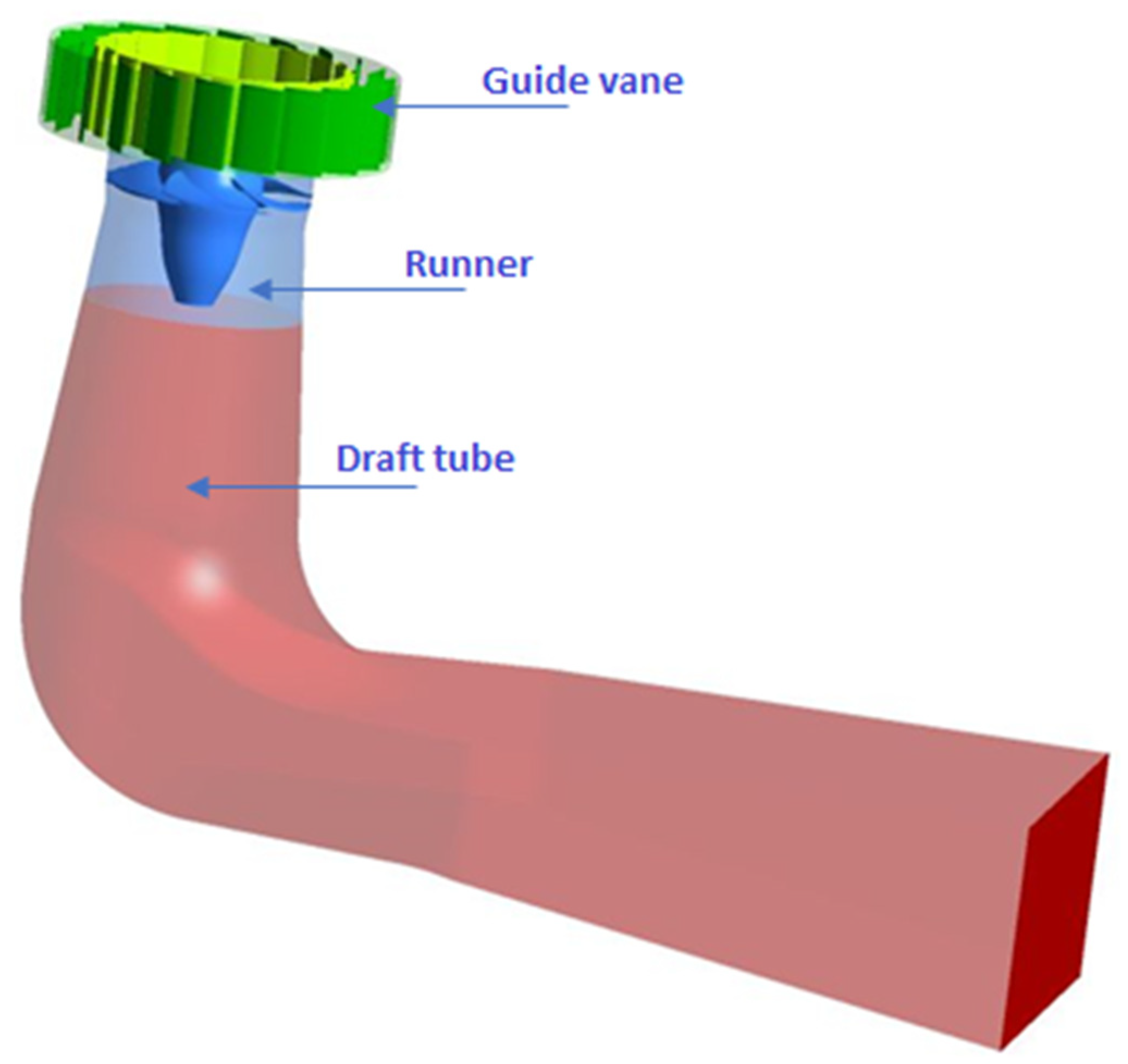
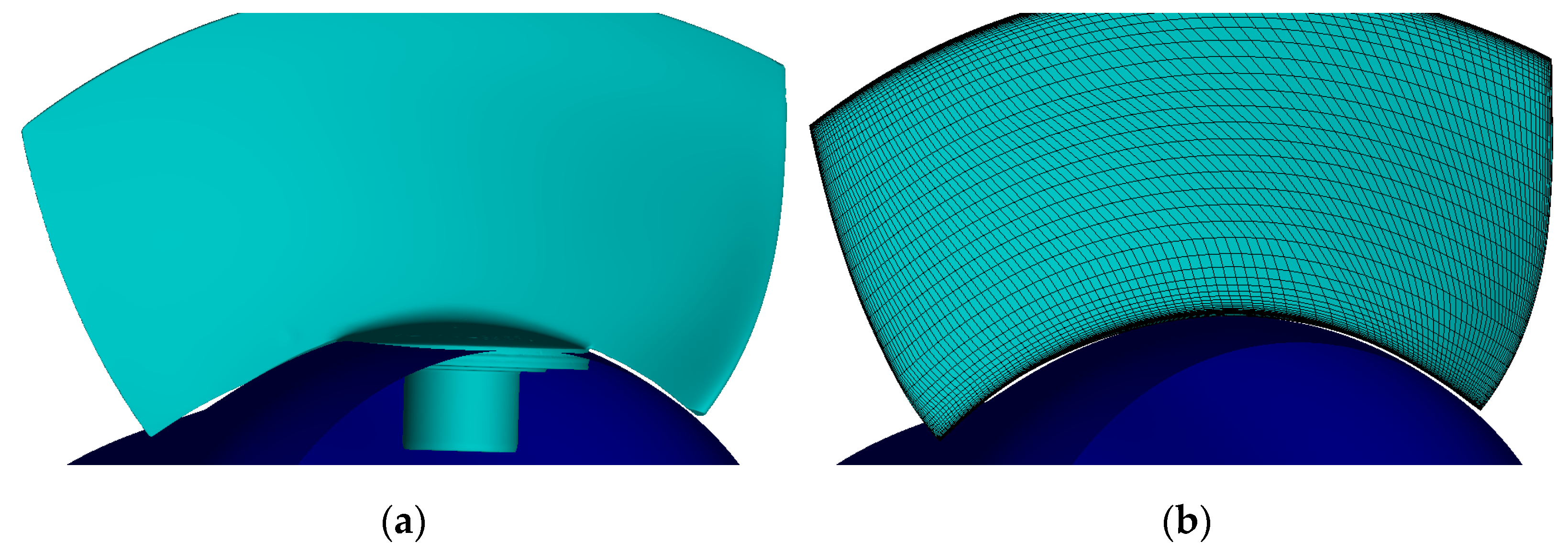
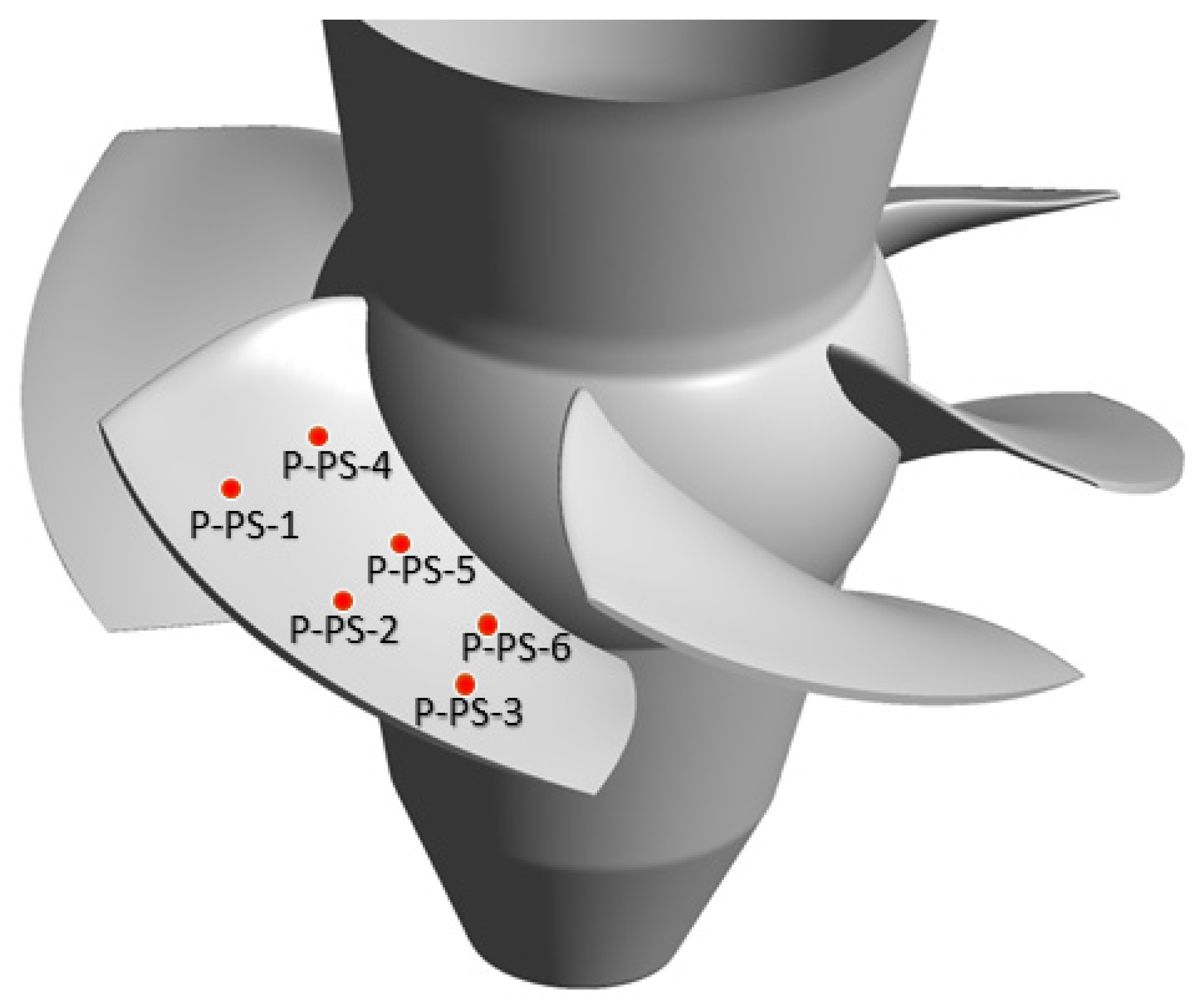

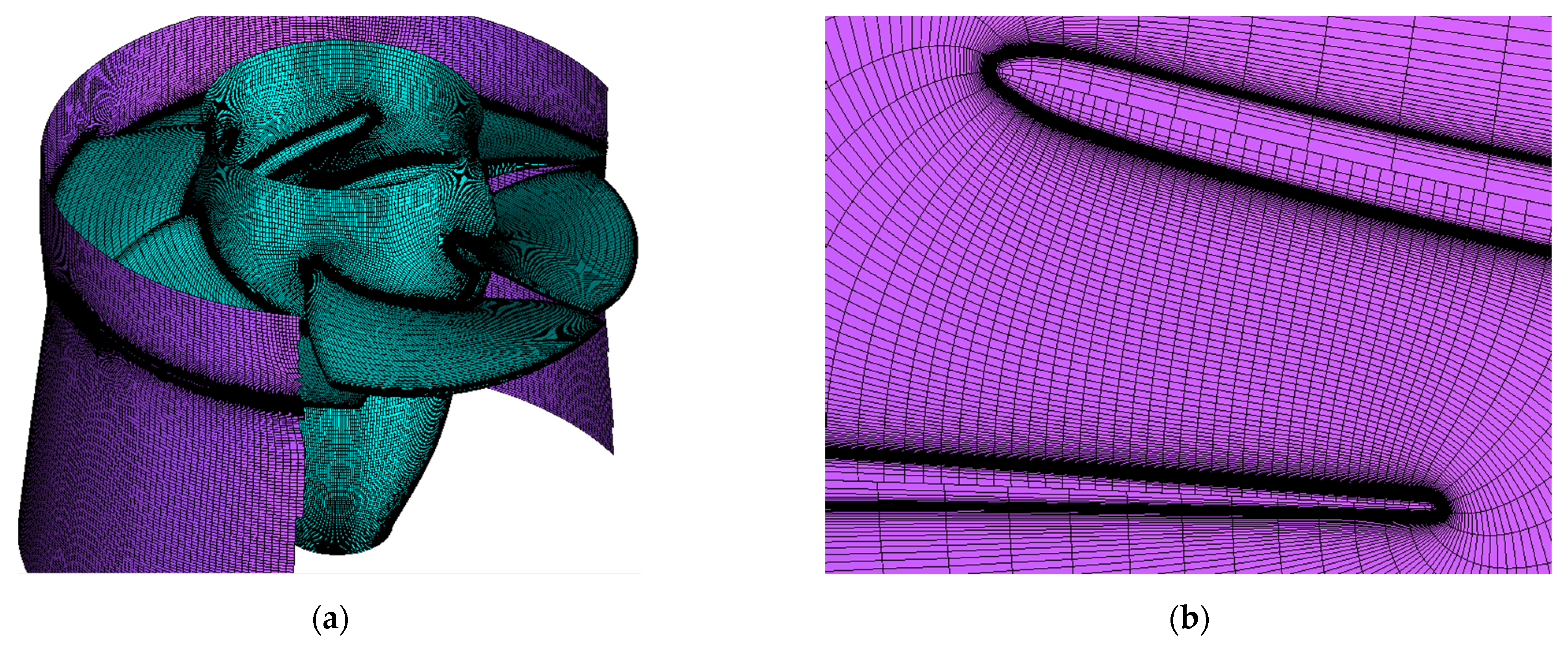
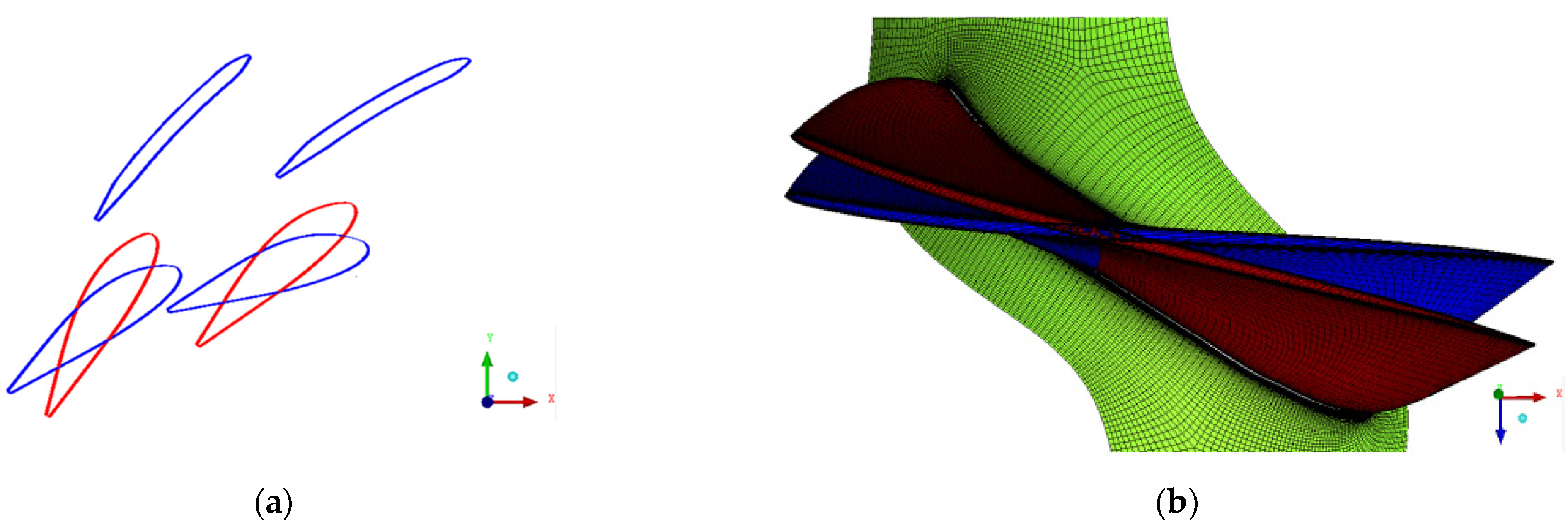
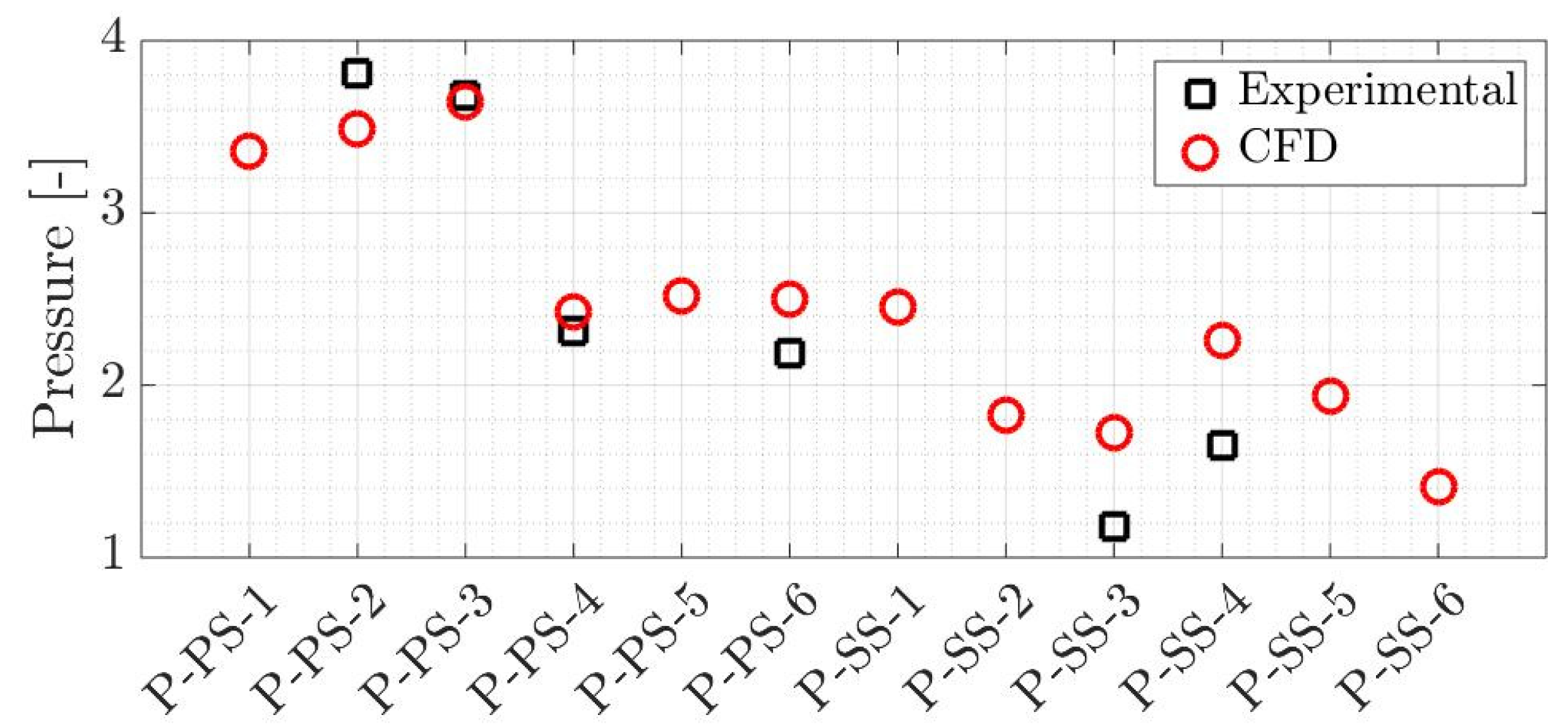
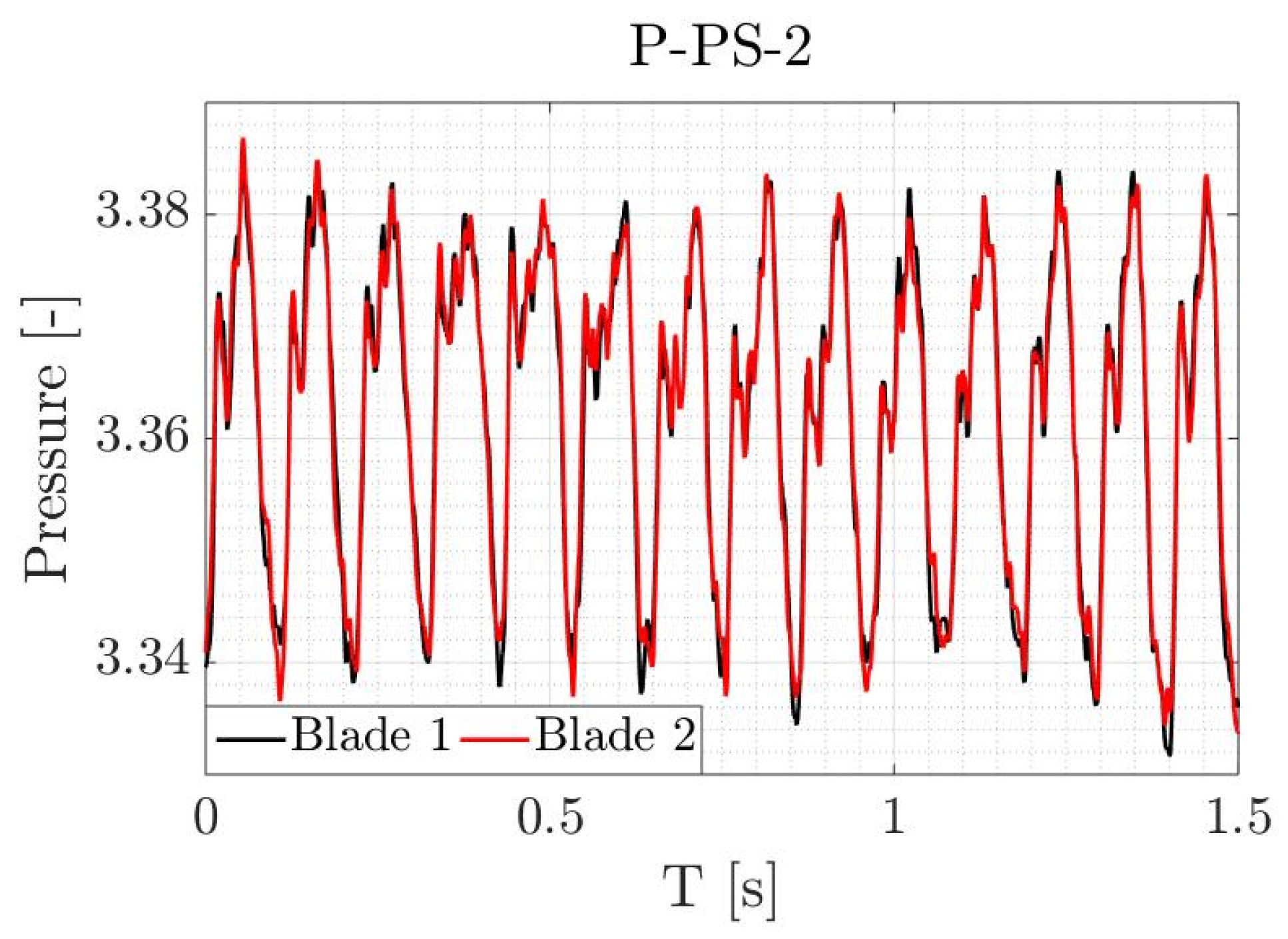

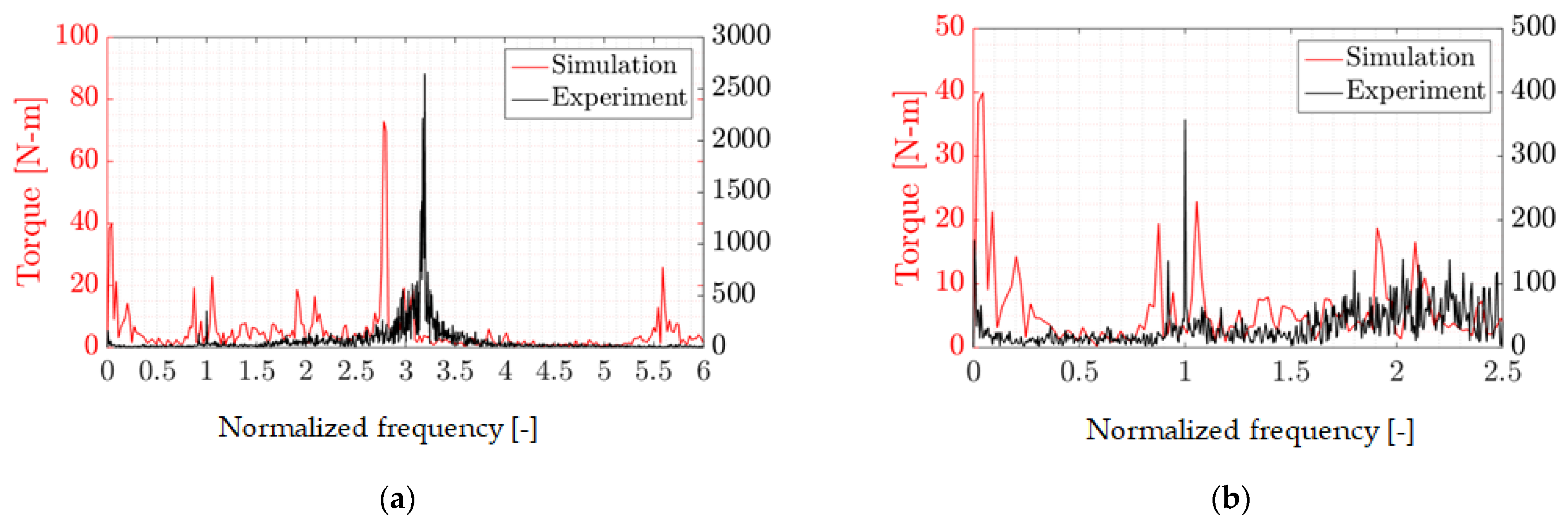
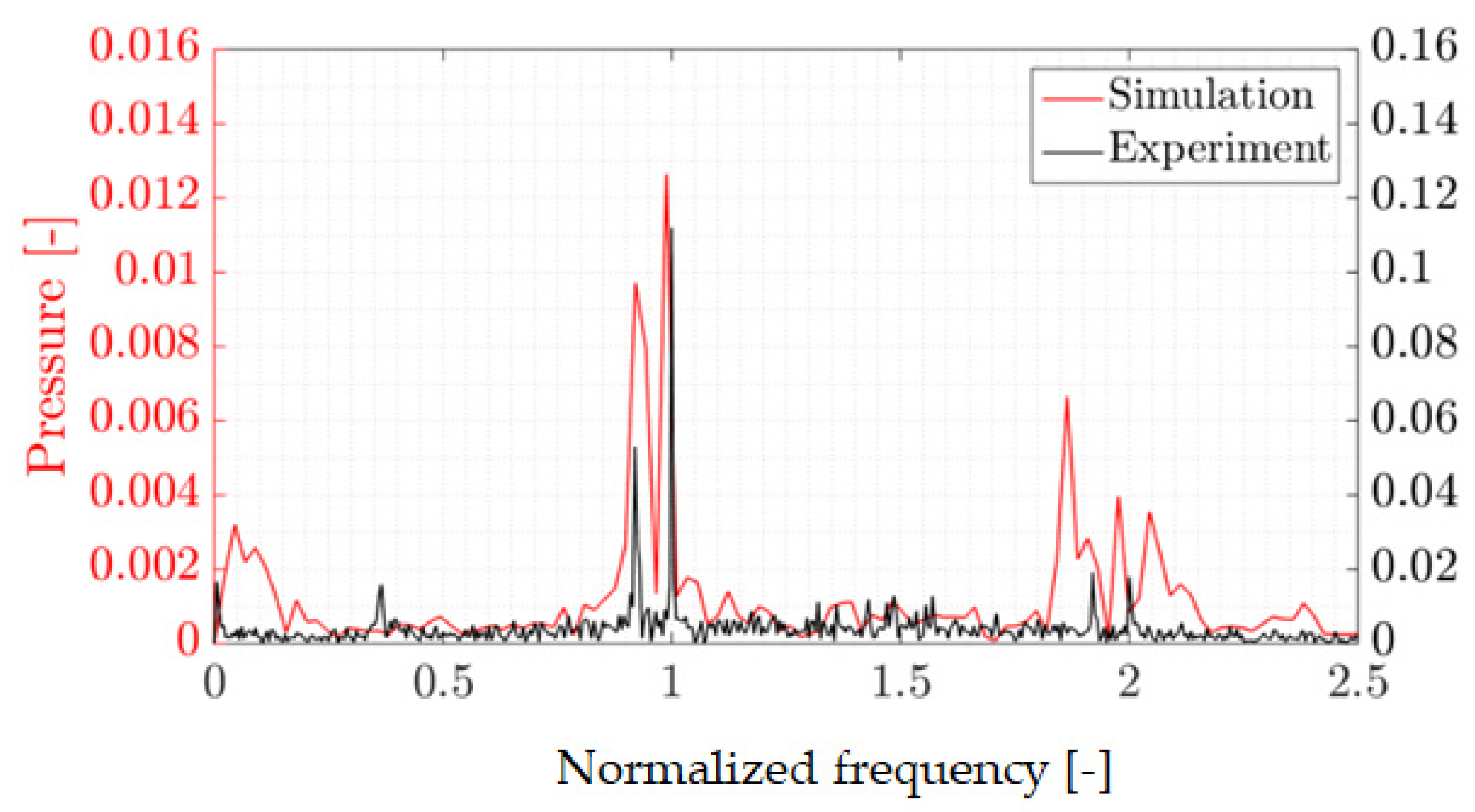
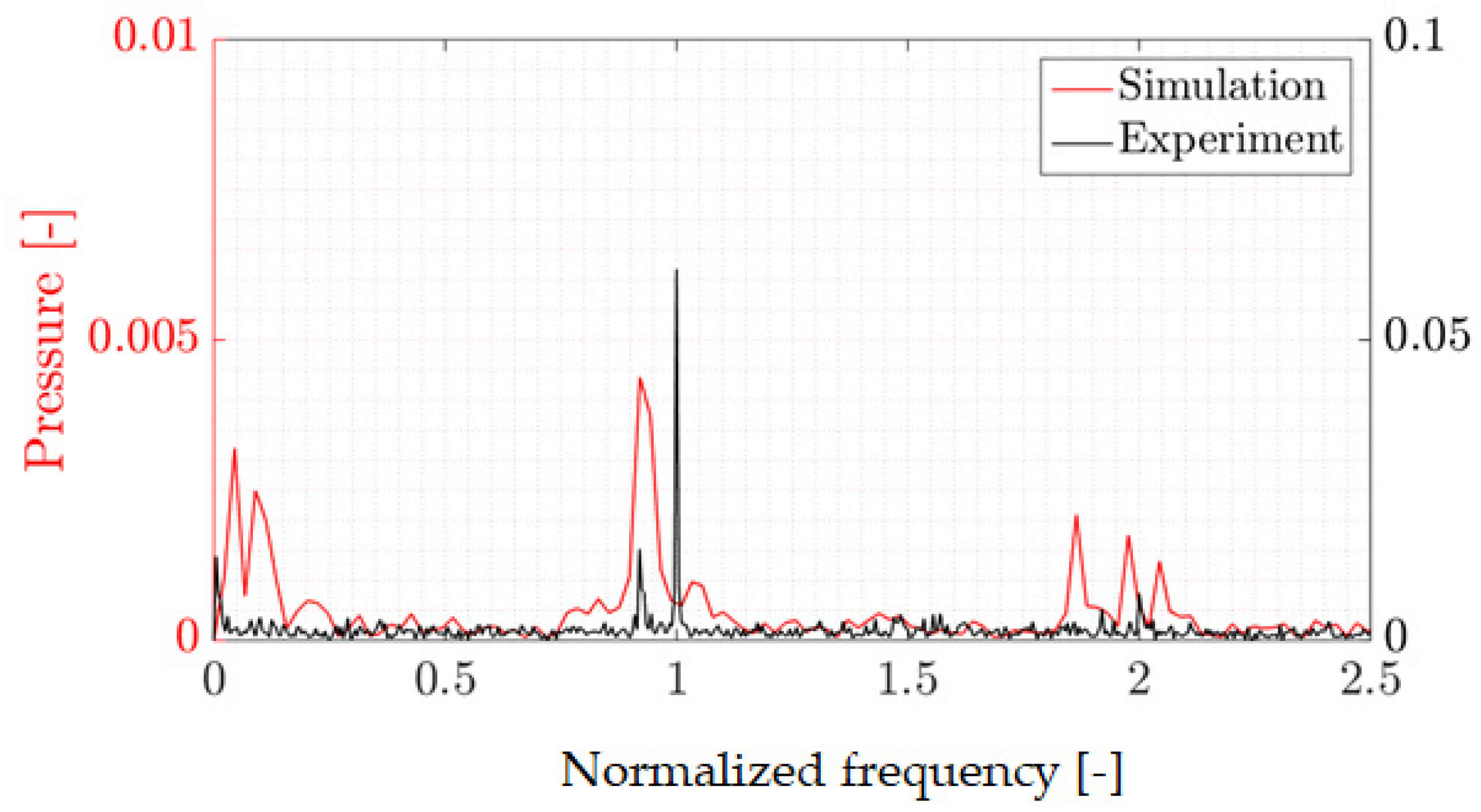

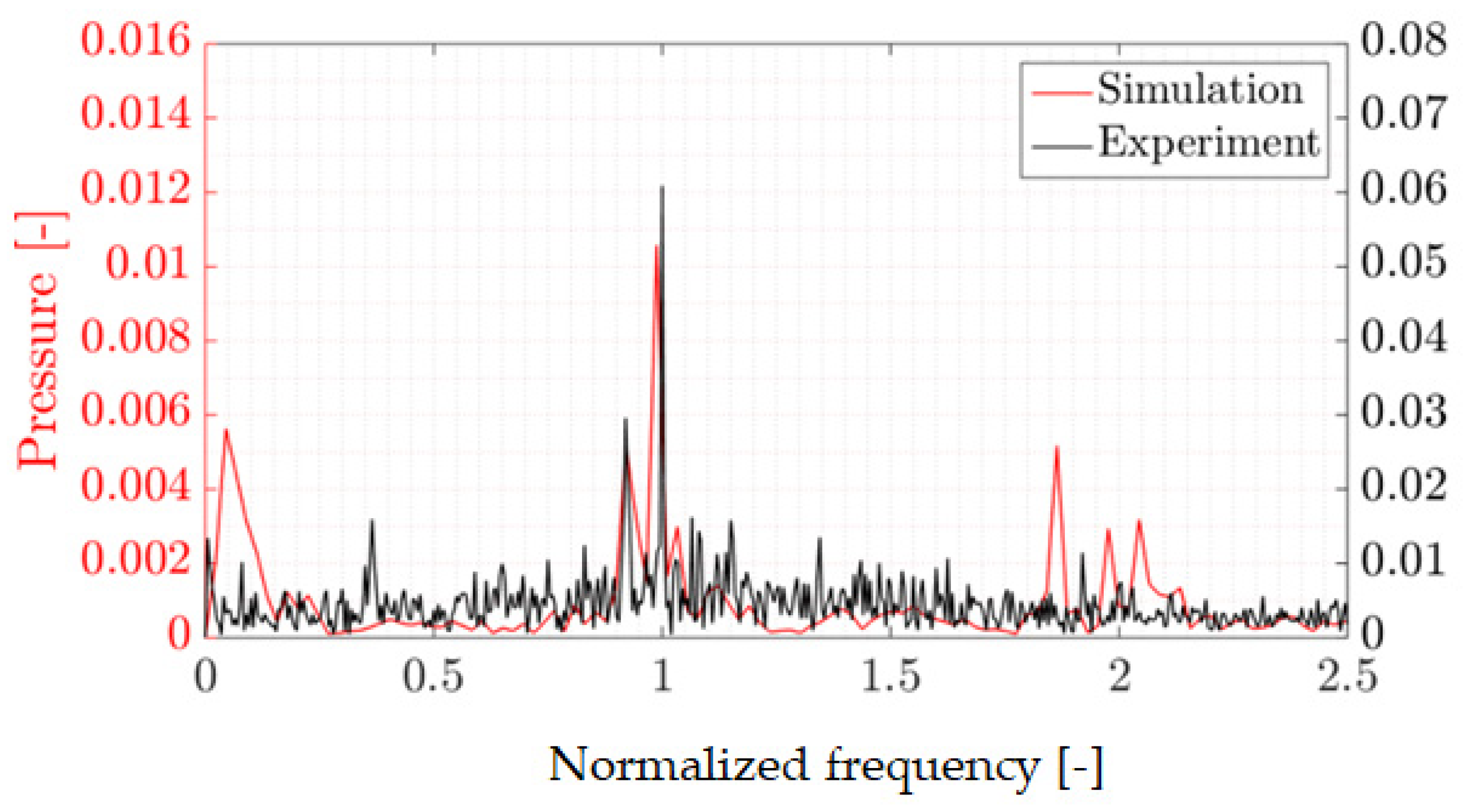
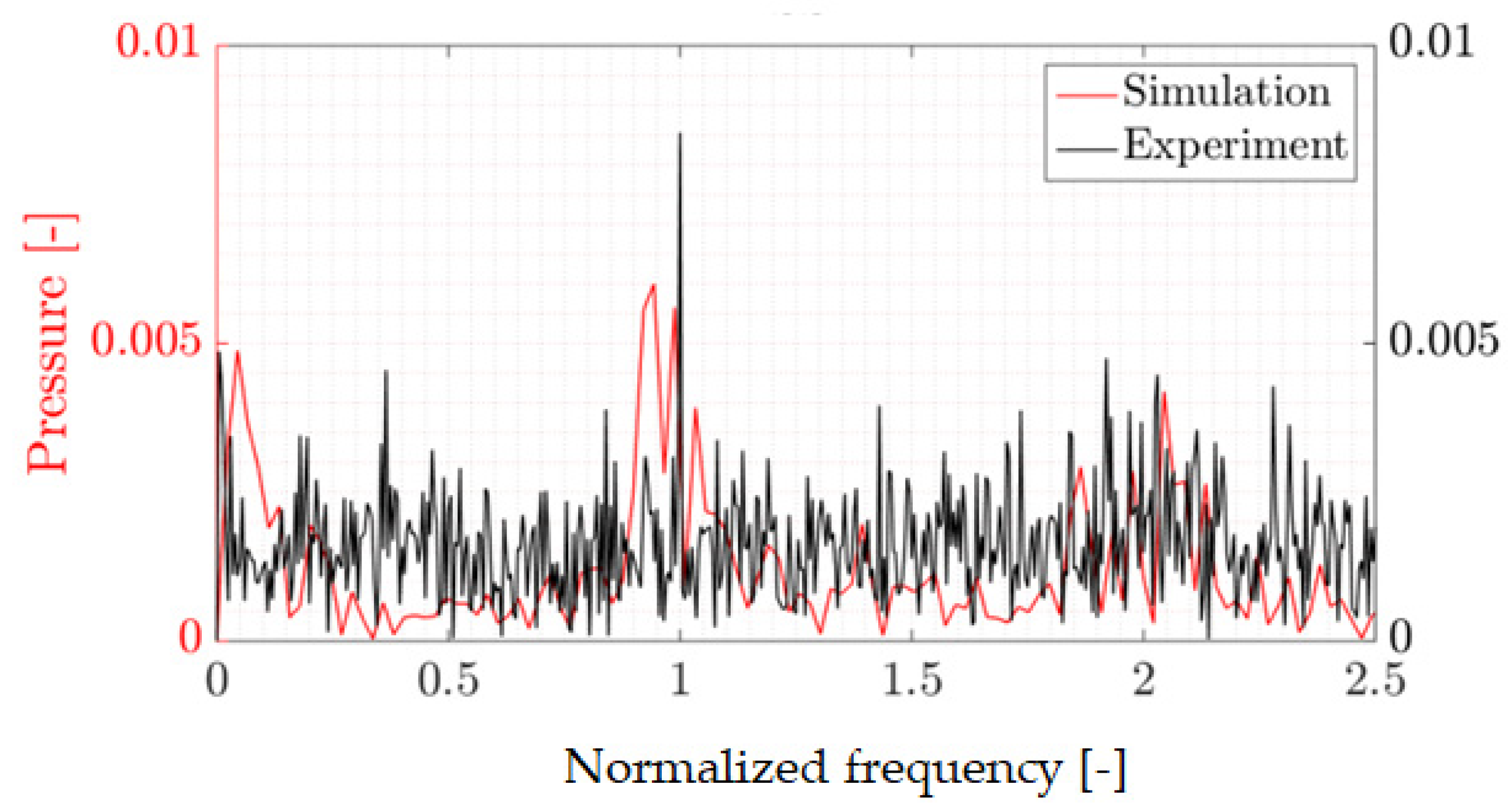
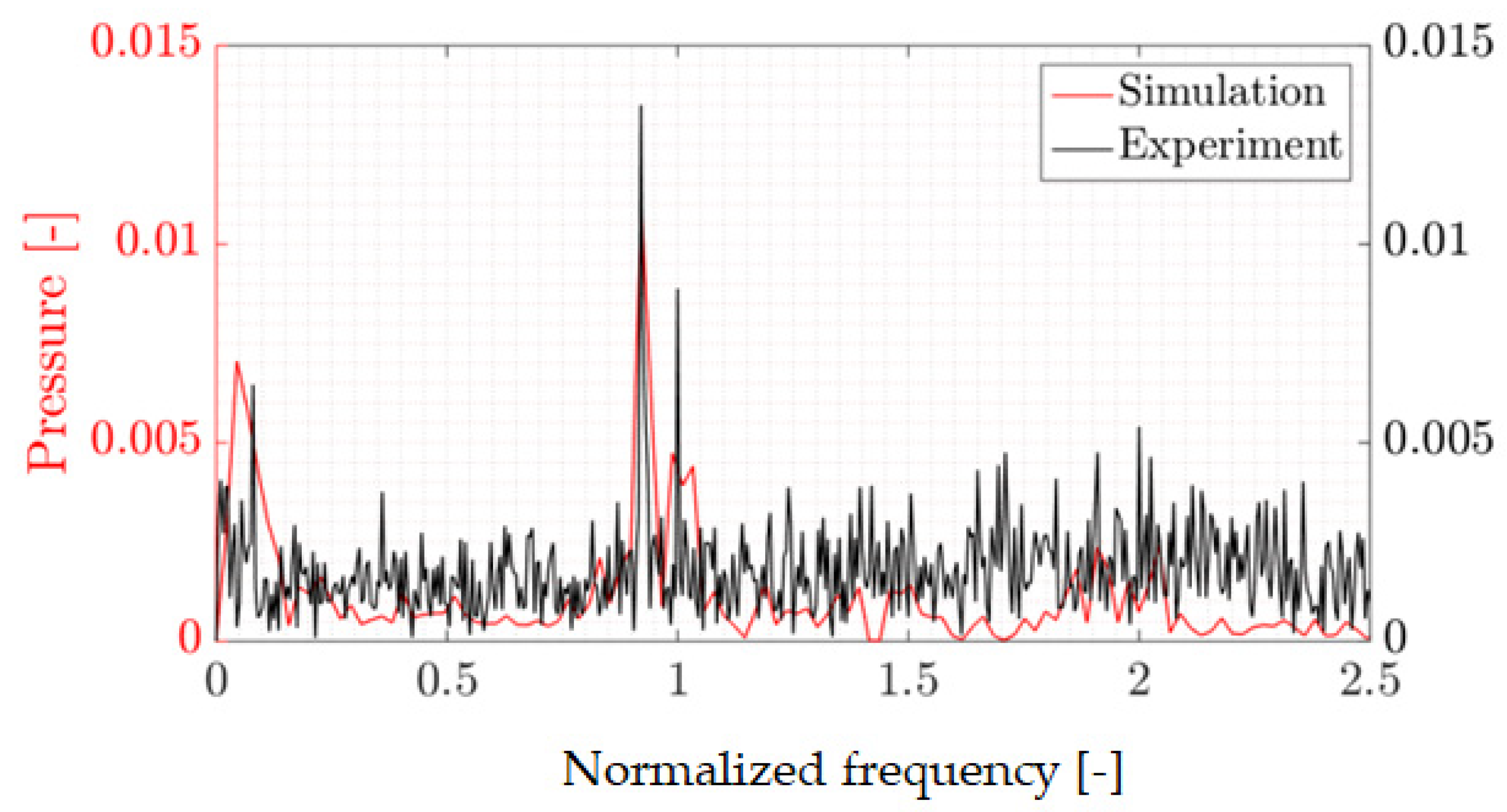


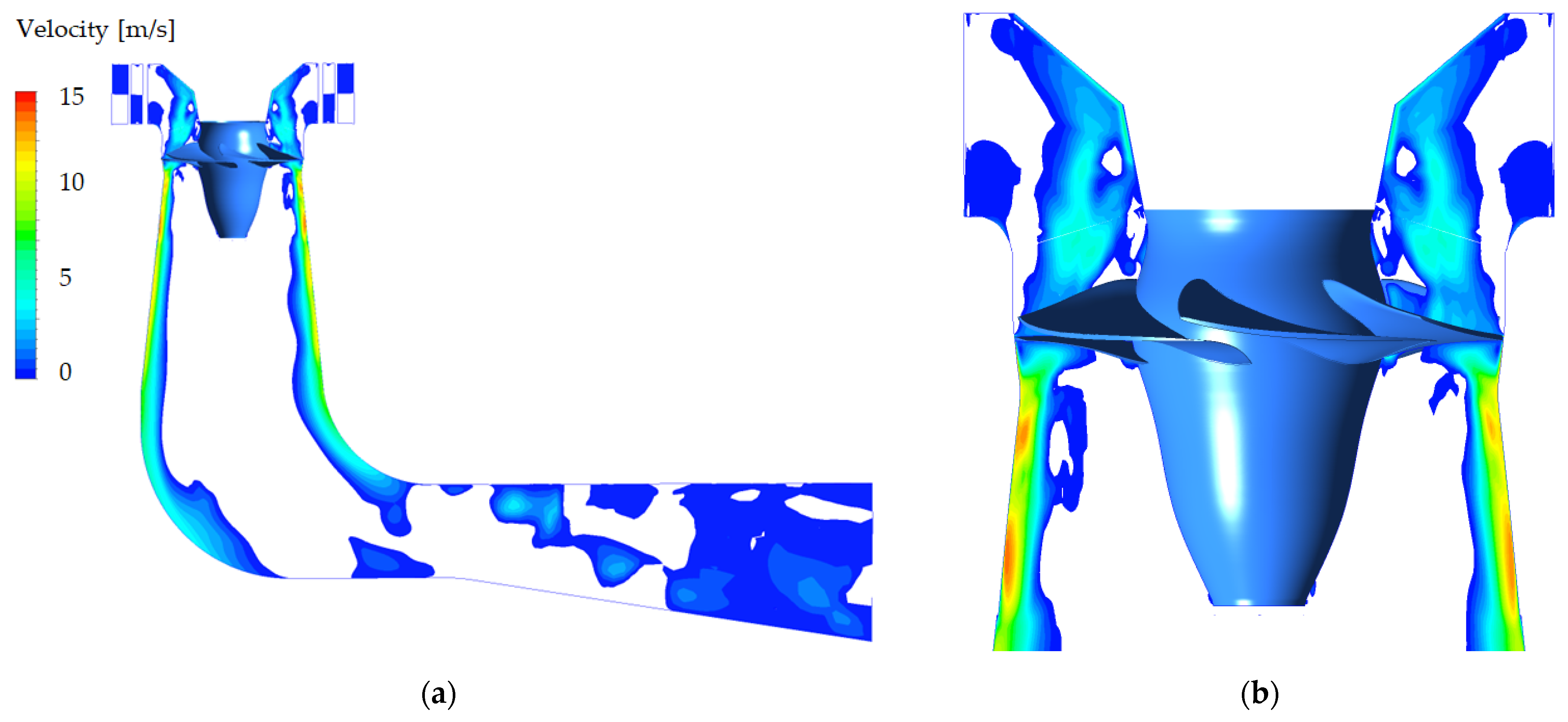

| Operating Point | Guide Vane Angle (°) | Runner Blade Angle β (°) |
|---|---|---|
| SNL | 3.08 | −15.23 |
| Domain Name | Mesh Size (106 Elements) | Minimum Orthogonality Angle (°) | Maximum Expansion Factor [-] | Aspect Ratio [-] |
|---|---|---|---|---|
| Guide vane | 3.64 | 5.8 | 34 | 1369 |
| Runner | 12.9 | 40.9 | 10 | 1481 |
| Draft tube | 3.18 | 30.5 | 9 | 7393 |
| Parameter | Boundary Condition |
|---|---|
| Inlet total pressure | 695 kPa |
| Outlet static pressure | 218 kPa |
| Rotational speed | 600 rpm |
| Sensor Location | Experimental Values [kPa] | Numerical Values [kPa] | ε [%] |
|---|---|---|---|
| P-PS-2 | 3.8 | 3.5 | −8.6 |
| P-PS-3 | 3.7 | 3.6 | −1.0 |
| P-PS-4 | 2.3 | 2.4 | 4.6 |
| P-PS-6 | 2.2 | 2.5 | 14.6 |
| P-SS-3 | 1.2 | 1.7 | 46.0 |
| P-SS-4 | 1.6 | 2.3 | 37.2 |
| Sensor Location | Experimental Values [-] | Numerical Values [-] | Experimental Values [-] | Numerical Values [-] |
|---|---|---|---|---|
| 1st Pressure Peak | 2nd Pressure Peak | |||
| P-PS-2 | 0.92 | 0.92 | 1 | 1.03 |
| P-PS-3 | 0.92 | 0.94 | 1 | 0.99 |
| P-PS-4 | 0.92 | 0.92 | 1 | 0.99 |
| P-PS-6 | 0.92 | 0.92 | 1 | 0.99 |
| P-SS-3 | 0.92 | 0.92 | 1 | 0.99 |
| P-SS-4 | - | 0.94 | 1 | 0.99 |
Publisher’s Note: MDPI stays neutral with regard to jurisdictional claims in published maps and institutional affiliations. |
© 2022 by the authors. Licensee MDPI, Basel, Switzerland. This article is an open access article distributed under the terms and conditions of the Creative Commons Attribution (CC BY) license (https://creativecommons.org/licenses/by/4.0/).
Share and Cite
Iovănel, R.G.; Dehkharqani, A.S.; Cervantes, M.J. Numerical Simulation of a Kaplan Prototype during Speed-No-Load Operation. Energies 2022, 15, 5072. https://doi.org/10.3390/en15145072
Iovănel RG, Dehkharqani AS, Cervantes MJ. Numerical Simulation of a Kaplan Prototype during Speed-No-Load Operation. Energies. 2022; 15(14):5072. https://doi.org/10.3390/en15145072
Chicago/Turabian StyleIovănel, Raluca Gabriela, Arash Soltani Dehkharqani, and Michel Jose Cervantes. 2022. "Numerical Simulation of a Kaplan Prototype during Speed-No-Load Operation" Energies 15, no. 14: 5072. https://doi.org/10.3390/en15145072
APA StyleIovănel, R. G., Dehkharqani, A. S., & Cervantes, M. J. (2022). Numerical Simulation of a Kaplan Prototype during Speed-No-Load Operation. Energies, 15(14), 5072. https://doi.org/10.3390/en15145072






